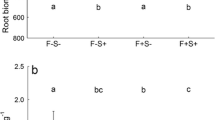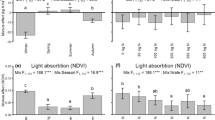Abstract
Positive species richness–productivity relationships are common in biodiversity experiments, but how resource availability modifies biodiversity effects in grass–legume mixtures composed of highly productive species is yet to be explicitly tested. We addressed this question by choosing two grasses (Arrhenatherum elatius and Dactylis glomerata) and two legumes (Medicago × varia and Onobrychis viciifolia) which are highly productive in monocultures and dominant in mixtures (the Jena Experiment). We established monocultures, all possible two- and three-species mixtures, and the four-species mixture under three different resource supply conditions (control, fertilization, and shading). Compared to the control, community biomass production decreased under shading (−56 %) and increased under fertilization (+12 %). Net diversity effects (i.e., mixture minus mean monoculture biomass) were positive in the control and under shading (on average +15 and +72 %, respectively) and negative under fertilization (−10 %). Positive complementarity effects in the control suggested resource partitioning and facilitation of growth through symbiotic N2 fixation by legumes. Positive complementarity effects under shading indicated that resource partitioning is also possible when growth is carbon-limited. Negative complementarity effects under fertilization suggested that external nutrient supply depressed facilitative grass–legume interactions due to increased competition for light. Selection effects, which quantify the dominance of species with particularly high monoculture biomasses in the mixture, were generally small compared to complementarity effects, and indicated that these species had comparable competitive strengths in the mixture. Our study shows that resource availability has a strong impact on the occurrence of positive diversity effects among tall and highly productive grass and legume species.





Similar content being viewed by others
References
Aarssen LW (1997) High productivity in grassland ecosystems: effected by species diversity or productive species? Oikos 80:183–184
Bates D, Maechler M, Bolker B (2012) lme4: linear mixed-effects models using S4 classes. http://www.r-project.org
Cardinale BJ, Duffy JE, Gonzalez A, Hooper DU, Perrings C, Venail P, Narwani A, Mace GM, Tilman D, Wardle DA, Kinzig AP, Daily GC, Loreau M, Grace JB, Larigauderie A, Srivastava DS, Naeem S (2012) Biodiversity loss and its impact on humanity. Nature 486:59–67
de Wit CT, van den Bergh JP (1965) Competition between herbage plants. Neth J Agric Sci 13:212–221
Dimitrakopoulos PG, Schmid B (2004) Biodiversity effects increase linearly with biotope space. Ecol Lett 7:574–583
Fargione J, Tilman D, Dybzinski R, Hille Ris Lambers J, Clark C, Harpole WS, Knops JMH, Reich PB, Loreau M (2007) From selection to complementarity: shifts in the causes of biodiversity–productivity relationships in a long-term biodiversity experiment. Proc R Soc Lond B 274:871–876
Fridley JD (2002) Resource availability dominates and alters the relationship between species diversity and ecosystem productivity in experimental plant communities. Oecologia 132:271–277
Fridley JD (2003) Diversity effects on production in different light and fertility environments: an experiment with communities of annual plants. J Ecol 91:396–406
Grime JP (1998) Benefits of plant diversity to ecosystems: immediate, filter and founder effects. J Ecol 86:902–910
Grime JP (2001) Plant strategies, vegetation processes and ecosystem properties. Wiley, Chichester
Hartwig UA (1998) The regulation of symbiotic N2 fixation: a conceptual model of N feedback from the ecosystem to the gene expression level. Perspect Plant Ecol Evol Syst 1:92–120
He J-S, Bazzaz FA, Schmid B (2002) Interactive effects of diversity, nutrients and elevated CO2 on experimental plant communities. Oikos 97:337–348
Heisse K, Roscher C, Schumacher J, Schulze E-D (2007) Establishment of grassland species in monocultures: different strategies lead to success. Oecologia 152:435–447
Högberg P (1997) 15N natural abundance in soil–plant systems. New Phytol 137:179–203
Hooper DU, Chapin FS, Ewel JJ, Hector A, Inchausti P, Lavorel S, Lawton JH, Lodge DM, Loreau M, Naeem S, Schmid B, Setälä H, Symstad AJ, Vandermeer J, Wardle DA (2005) Effects of biodiversity on ecosystem functioning: a consensus of current knowledge. Ecol Monogr 75:3–35
Hothorn T, Bretz F, Westfall P (2008) Simultaneous inference in general parametric models. Biom J 50:346–363
Huston MA (1997) Hidden treatments in ecological experiments: re-evaluating the ecosystem function of biodiversity. Oecologia 110:449–460
Kluge G, Müller-Westermeier G (2000) Das Klima ausgewählter Orte der Bundesrepublik Deutschland: Jena. Ber Deutsch Wetterdienst 213:1–290
Lanta V, Lepš J (2007) Effects of species and functional group richness on production in two fertility environments: an experiment with communities of perennial plants. Acta Oecol 32:93–103
Lepš J (2004) What do the biodiversity experiments tell us about consequences of plant species loss in the real world? Basic Appl Ecol 5:529–534
Loreau M (1998) Separating sampling and other effects in biodiversity experiments. Oikos 82:600–602
Loreau M, Hector A (2001) Partitioning selection and complementarity in biodiversity experiments. Nature 412:72–76 [Erratum 413:548]
Marquard E, Weigelt A, Temperton VM, Roscher C, Schumacher J, Buchmann N, Fischer M, Weisser WW, Schmid B (2009) Plant species richness and functional composition drive overyielding in a 6-year grassland experiment. Ecology 90:3290–3302
Nyfeler D, Huguenin-Elie O, Suter M, Frossard E, Connolly J, Lüscher A (2009) Strong mixture effects among four species in fertilized agricultural grassland led to persistent and consistent transgressive overyielding. J Appl Ecol 46:683–691
Olff H, van Andel J, Bakker JP (1990) Biomass and shoot/root allocation of five species from a grassland succession series at different combinations of light and nutrient supply. Funct Ecol 4:193–200
Palmborg C, Scherer-Lorenzen M, Jumpponen A, Carlsson G, Huss-Danell K, Högberg P (2005) Inorganic soil nitrogen under grassland plant communities of different species composition and diversity. Oikos 110:271–281
Rajaniemi TK (2003) Evidence for size asymmetry of belowground competition. Basic Appl Ecol 4:239–247
Reich PB, Knops J, Tilman D, Craine J, Ellsworth D, Tjoelker M, Lee T, Wedin D, Naeem S, Bahauddin D, Hendrey G, Jose S, Wrage K, Goth J, Bengston W (2001) Plant diversity enhances ecosystem responses to elevated CO2 and nitrogen deposition. Nature 410:809–810
Roscher C, Schumacher J, Baade J, Wilcke W, Gleixner G, Weisser WW, Schmid B, Schulze E-D (2004) The role of biodiversity for element cycling and trophic interactions: an experimental approach in a grassland community. Basic Appl Ecol 5:107–121
Roscher C, Temperton VM, Scherer-Lorenzen M, Schmitz M, Schumacher J, Schmid B, Buchmann N, Weisser WW, Schulze E-D (2005) Overyielding in experimental grassland communities—irrespective of species pool or spatial scale. Ecol Lett 8:419–429
Roscher C, Schumacher J, Weisser WW, Schmid B, Schulze E-D (2007) Detecting the role of individual species for overyielding in experimental grassland communities composed of potentially dominant species. Oecologia 154:535–549
Roscher C, Scherer-Lorenzen M, Schumacher J, Temperton VM, Buchmann N, Schulze E-D (2011) Plant resource-use characteristics as predictors for species contribution to community biomass in experimental grasslands. Perspect Plant Ecol Evol Syst 13:1–13
Schwinning S, Weiner J (1998) Mechanisms determining the degree of size asymmetry in competition among plants. Oecologia 113:447–455
Spehn EM, Hector A, Joshi J, Scherer-Lorenzen M, Schmid B, Bazeley-White E, Beierkuhnlein C, Caldeira MC, Diemer M, Dimitrakopoulos PG, Finn JA, Freitas H, Giller PS, Good J, Harris R, Högberg P, Huss-Danell K, Jumpponen A, Koricheva J, Leadley PW, Loreau M, Minns A, Mulder CPH, O’Donovan G, Otway SJ, Palmborg C, Pereira JS, Pfisterer AB, Prinz A, Read DJ, Schulze E-D, Siamantziouras A-SD, Terry AC, Troumbis AY, Woodward FI, Yachi S, Lawton JH (2005) Ecosystem effects of biodiversity manipulations in European grasslands. Ecol Monogr 75:37–63
Stitt M, Schulze E-D (1994) Plant growth, storage and resource allocation: from flux control in a metabolic chain to the whole-plant level. In: Schulze E-D (ed) Flux control in biological systems: from enzymes to populations and ecosystems. Academic, San Diego, pp 57–118
Tilman D (1988) Plant strategies and the dynamics and structure of plant communities. Princeton University Press, Princeton
Tilman D, Knops J, Wedin D, Reich P, Ritchie M, Siemann E (1997) The influence of functional diversity and composition on ecosystem processes. Science 277:1300–1302
van Ruijven J, Berendse F (2003) Positive effects of plant species diversity on productivity in the absence of legumes. Ecol Lett 6:170–175
Vitousek PM, Howarth RW (1991) Nitrogen limitation on land use and in the sea: how can it occur? Biogeochemistry 13:87–115
Wacker L, Baudois O, Eichenberger-Glinz S, Schmid B (2009) Diversity effects in early- and mid-successional species pools along a nitrogen gradient. Ecology 90:637–648
Wang C, Wan S, Xing X, Zhang L, Han X (2006) Temperature and soil moisture interactively affected soil net N mineralization in temperate grasslands in Northern China. Soil Biol Biochem 5:1101–1110
Acknowledgments
This study was part of the Jena Experiment and supported by the German Science Foundation (RO2397/1 within FOR456). We acknowledge A. Weigelt for field coordination. We thank U. Gerighausen, S. Ferber, C. Kups, the gardeners, and several student helpers for their support with the establishment and management of the four-species experiment and during sampling; I. Hilke, S. Matthei, and H. Geilmann for conducting chemical and stable isotope analyses; F. Voigt and B. Schlöffel for the construction of the shade roof; K. Hippler, M. Hertel, and A. Fastnacht for setting up and maintaining the weather station; and three anonymous reviewers for their helpful comments on a previous version of the manuscript.
Author contribution statement
CR, E-DS, BS, and OK conceived and designed the experiment. CR and OK performed the experiment. CR analyzed the data and wrote the manuscript; E-DS and BS discussed the results and contributed to writing the manuscript; OK provided editorial advice.
Author information
Authors and Affiliations
Corresponding author
Additional information
Communicated by Scott Collins.
Electronic supplementary material
Below is the link to the electronic supplementary material.
Rights and permissions
About this article
Cite this article
Roscher, C., Schmid, B., Kolle, O. et al. Complementarity among four highly productive grassland species depends on resource availability. Oecologia 181, 571–582 (2016). https://doi.org/10.1007/s00442-016-3587-4
Received:
Accepted:
Published:
Issue Date:
DOI: https://doi.org/10.1007/s00442-016-3587-4




